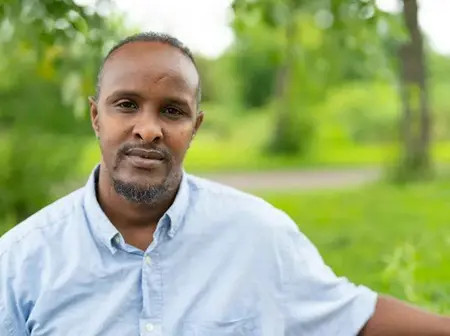Tobacco educators reach out to families about the dangers of smoking — no matter its delivery system — and second-hand smoke.
Abdillahi Kahin, pictured on Aug. 22, of Wellshare International, works toward reducing tobacco use in the Somali community. (Aaron Nesheim/Sahan Journal)
When Hassan Mohamed, a tobacco use prevention coordinator with African Immigrants Community Services of Minneapolis, talks with Somali youths about the hazards of tobacco, he finds himself facing two main adversaries: vaping and hookahs.
Hassan, who has been on the job for six months, and his team hear of those tobacco delivery systems’ popularity during their visits to schools and community centers.
“A lot of youth [vape] nowadays — high schoolers, college students — and actually fall for advertising for different flavors,” he said. “The Somali community are also doing what’s called hookah, which is a different kind of smoking.”
According to the most recent Minnesota Youth Tobacco Survey by the state Department of Health, the rate of teens who took their first hit of a nicotine vape or e-cigarette in 2023 nearly doubled, to 30%, since 2017. About 1 in 10 teens reported using vapes and e-cigarettes regularly, with 80% of those teens reporting being dependent on them.
The good news from the report is that 65% of teen tobacco users had tried to quit, compared to 54% of teens in the 2017 survey.
The Commercial Tobacco-Free Communities Grant Program, using Minnesota Department of Health funding, provides money to local groups for programming aimed at preventing and reducing youth tobacco use.
African Immigrants Community Services was among the first group of grant recipients, with funding from 2022 to 2026. Each grantee receives between $100,000 and $150,000 per year to tailor their prevention efforts to fit the needs of the communities they serve.
Hassan said there is a tendency in the Somali community to hide tobacco use, which makes it harder to intervene.
“We’re East African, so in our community, [tobacco use] is kind of taboo,” Hassan said. “For some elders, it’s OK to smoke, but the younger ones don’t want to be seen in public, so they smoke privately, or they prefer electronic vapes.”
Throughout his work, some trends Hassan and his team have seen include older Somali men choosing cigarettes, while vapes and e-cigarettes are prevalent among younger Somalis. Trends in hookah use, however, have more to do with gender, he said.
“Hookah is used by a lot of women,” he said.
Researchers at the University of Minnesota are also trying to help Somali tobacco users kick the habit. Dr. April Wilhelm, an assistant professor and researcher, is in the second year of a two-year project funded by the U’s Masonic Cancer Center that is examining Somali parents’ perception of the health risks of hookah use to themselves and via secondhand smoke to other household members, particularly children.
Wilhelm said the study was prompted by data from studies over the past 15 years that suggest an increase in Somali use of hookahs in their homes, and increasing exposure to secondhand smoke.
A hookah, also called a shisha, is a water pipe that heats flavored tobacco with charcoal, filters the smoke through water to cool it, then delivers the smoke to the user via a hose. It presents the same health dangers as other forms of tobacco use, medical experts say.
Wilhelm partnered with WellShare International, a community health organization based in Minneapolis. WellShare’s health workers, who are from the communities they serve, interviewed people in Somali about their tobacco use and recruited them to take part in the project’s focus groups.
Wilhelm and her team worked with six focus groups that involved 40 Somali parents, and also interviewed 10 professionals who are Somali American or work closely with the community in areas that included health care, social work, education and religion.
The biggest takeaway, she said, was a widespread lack of knowledge about the health hazards of hookah use.
“That came up over and over again, about people’s perceptions around this being less risky than other burned products related to tobacco use, combustible products,” she said. “That was just a really key message.”
Researchers used that information to develop an intervention program with visits by WellShare community health workers to families that smoke hookah to discuss the health risks.
Abdillahi Kahin, a senior program manager with WellShare, said shared cultural knowledge and language are crucial in this process.
“When you know deeply what you are talking about, because you are from the same community, you talk about it differently than somebody from outside of the community,” Kahin said.
State officials had struggled to to reach certain communities, said Parker Smith, the MDH’s communication specialist on prevention and policy efforts related to commercial tobacco.
“For example, in American Indian communities, tobacco is a sacred medicine, and so that had been a barrier in the past to implementing effective strategies,” he said. “Before doing that preventative work, we had to engage the community on sacred and traditional tobacco.”
Through the Tobacco-Free Communities Grant Program, state officials can fund organizations like African Immigrant Community Services and WellShare International that provide culturally specific strategies to prevent tobacco use.

Leave a Reply